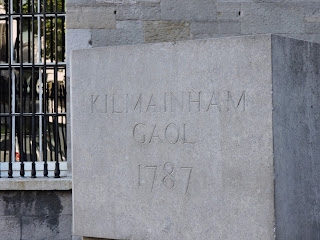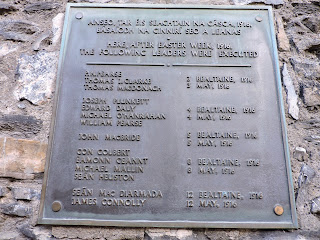 |
| We're off to find Kilmainham... |
 |
| Found it! |
Kilmainham Jail has been around since the 1700's and has held countless famous political prisoners, but it is most famous for being the place the 1916 Rising rebels spent their last days before they were shot.
Joesph Plunkett is probably one of the most famous of these men. Not really because he was an amazing leader, but because of his tragic story. He was a poet and in love with a woman named Grace. On his final night in the jail, he and Grace were finally married in the chapel in Kilmainham. They were then separated and later given about 10 minutes to say goodbye before he was taken out and shot with the 13 others at dawn.
This song is a tragically sad story of their last night.
 |
| Joesph and Grace Plunkett |
 |
| Spiral stairs |
We were able to look into the cell she stayed in.
In this cell, she painted St. Mary on the wall.
Some of the cells were opened. This is what a cell in the new part of Kilmainham Jail looks like.
Then we saw what the old part of the jail looked like. It was far lass nice and more typical.
 |
| The inside of a cell in the old jail. |
Across from the place where James Connolly was shot, is a cross that marks the place where the 13 other men stood before the firing squad and were killed one by one.
At the time of the Rising, it was probably the most unpopular rising in Irish History. When these rebels were taken away, even the locals were scoffing and spitting on them. This was because the rising took place during World War one when thousands of Irish men were overseas dying.
But the British made a fatal mistake by shooting these 14 rebels. In doing so, they became martyrs. In the course of two months, the support of the Irish had swung behind the Rising, and they were stirred up against the British, and in the following years, Ireland finally shook off the control of England.
The flag of the Irish Republic now stands in the courtyard of Kilmainham -- the result of what these men died for.
The symbol of Ireland -- the Irish harp -- is now on the wall in the room where the rebels were tried.
Under the harp is the Gaelic name for Ireland -- Eire.

















No comments:
Post a Comment